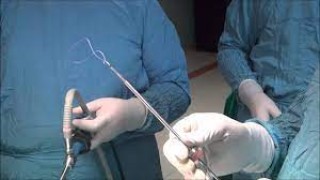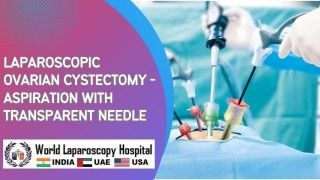Laparoscopic Removal of a 3.5 Kg Fibroid, Ovarian Cyst, Gallbladder & Appendix—A World's First
Add to
Share
1,225 views
Report
2 years ago
Description
Introduction: Laparoscopic surgery has revolutionized the field of minimally invasive procedures, allowing surgeons to perform complex surgeries with remarkable precision and minimal patient trauma. In a groundbreaking achievement, a surgical team accomplished the world's first laparoscopic removal of a 3.5 kg fibroid, ovarian cyst, gallbladder, and appendix. This essay explores the significance of this pioneering feat, highlighting the exceptional surgical expertise, technological advancements, and the potential impact on patient care. Body: The Complexity of the Procedure: The simultaneous removal of a large fibroid, ovarian cyst, gallbladder, and appendix presents an extraordinary surgical challenge. Each condition requires careful evaluation, precise surgical planning, and meticulous execution to ensure successful outcomes. The laparoscopic approach, with its small incisions and specialized instruments, offers the ideal platform to tackle these multiple complexities with minimal invasiveness. Surgical Expertise and Collaborative Efforts: Accomplishing such a remarkable feat requires a highly skilled surgical team with expertise in various specialties, including gynecology, general surgery, and advanced laparoscopy. The successful outcome of this procedure is a testament to the collaborative efforts, extensive training, and experience of the surgical team involved. Their expertise, coupled with innovative surgical techniques, played a pivotal role in achieving this unprecedented milestone. Technological Advancements: Technological advancements have played a crucial role in enabling the successful execution of complex laparoscopic surgeries. High-definition imaging systems, advanced laparoscopic instruments, and energy devices have significantly enhanced visualization, tissue manipulation, and hemostasis during these procedures. These technological advancements empower surgeons to perform intricate surgeries with greater precision, ensuring optimal patient outcomes. Impact on Patient Care: The laparoscopic removal of a 3.5 kg fibroid, ovarian cyst, gallbladder, and appendix marks a significant breakthrough in patient care. By utilizing a minimally invasive approach, patients benefit from reduced post-operative pain, shorter hospital stays, faster recovery, and improved cosmetic outcomes compared to traditional open surgeries. Furthermore, the simultaneous removal of multiple conditions eliminates the need for separate procedures, streamlining patient care and reducing the overall healthcare burden. Advancements in Minimally Invasive Surgery: This pioneering feat sets a new precedent for the possibilities of laparoscopic surgery. It showcases the continuous advancements in minimally invasive techniques and reinforces the potential for surgeons to address complex pathologies through small incisions. As this achievement gains recognition, it may inspire further innovation and encourage the exploration of similar approaches for complex surgical cases, ultimately benefiting patients worldwide. In a remarkable medical breakthrough, a surgical team achieved an unprecedented feat by successfully performing the world's first laparoscopic removal of a 3.5 kg fibroid, ovarian cyst, gallbladder, and appendix. This extraordinary achievement showcases the exceptional surgical expertise, advanced technology, and collaborative efforts that have propelled the field of minimally invasive surgery to new heights. The complexity of this procedure cannot be overstated. The removal of a large fibroid, ovarian cyst, gallbladder, and appendix simultaneously demands meticulous planning, precision, and coordination among multiple surgical specialties. The laparoscopic approach, with its small incisions and specialized instruments, provided the ideal platform to address these intricate challenges with minimal trauma to the patient. At the heart of this groundbreaking achievement lies the exceptional surgical expertise and collaborative efforts of a highly skilled team. Surgeons specializing in gynecology, general surgery, and advanced laparoscopy joined forces to tackle this complex case. Their extensive training, experience, and multidisciplinary approach were instrumental in ensuring the successful outcome of the procedure. By leveraging their collective knowledge and skills, the surgical team demonstrated the immense potential that can be achieved through collaboration and the sharing of expertise. Technological advancements played a pivotal role in the success of this milestone surgery. State-of-the-art high-definition imaging systems provided the surgical team with unparalleled visualization of the surgical field, enabling them to navigate and manipulate delicate structures with precision. Advanced laparoscopic instruments and energy devices further enhanced surgical capabilities, facilitating tissue dissection, hemostasis, and organ removal. These technological advancements not only contributed to the successful completion of the procedure but also minimized patient trauma, accelerated recovery, and optimized surgical outcomes. The impact of this pioneering feat on patient care cannot be overstated. By employing a minimally invasive approach, patients experienced reduced post-operative pain, shorter hospital stays, and faster recovery times compared to traditional open surgeries. The simultaneous removal of multiple conditions in a single procedure eliminated the need for separate surgeries, streamlining patient care and reducing the burden on the healthcare system. Furthermore, the exceptional cosmetic outcomes associated with laparoscopic surgery enhance patient satisfaction and contribute to their overall well-being. This groundbreaking achievement represents a significant advancement in the field of minimally invasive surgery and opens new possibilities for patients worldwide. As news of this feat spreads, it has the potential to inspire further innovation and encourage the exploration of similar approaches for complex surgical cases. The successful laparoscopic removal of a 3.5 kg fibroid, ovarian cyst, gallbladder, and appendix sets a new standard for surgical excellence, emphasizing the power of collaboration, technological advancements, and unwavering dedication to advancing patient care. This groundbreaking achievement not only represents a triumph for the surgical team involved but also signifies a monumental leap forward in the field of laparoscopic surgery. It serves as a testament to human ingenuity, perseverance, and the relentless pursuit of pushing the boundaries of medical innovation. As this milestone gains recognition, it will undoubtedly reshape the landscape of surgical practices, redefine standards of care, and inspire future breakthroughs in minimally invasive surgery on a global scale. Conclusion: The laparoscopic removal of a 3.5 kg fibroid, ovarian cyst, gallbladder, and appendix stands as a landmark achievement in the field of minimally invasive surgery. This pioneering feat exemplifies the power of surgical expertise, technological advancements, and collaborative efforts to overcome complex surgical challenges. As this remarkable milestone gains recognition, it has the potential to redefine standards of care and inspire future breakthroughs in the field of laparoscopic surgery. The achievement not only offers new possibilities for patient care but also signifies the unwavering commitment of the surgical community to push the boundaries of medical innovation.
Similar Videos






